
1970s in fashion
Encyclopedia
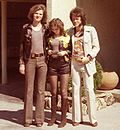
Bell-bottoms
Bell-bottoms are trousers that become wider from the knees downward. Related styles include flare, loon pants and boot-cut/leg trousers. Hip-huggers are bell-bottomed, flare, or boot-cut pants that are fitted tightly around the hips and thighs.-Naval origins:Bell-bottoms' precise origins are...
and the androgynous hippie
Hippie
The hippie subculture was originally a youth movement that arose in the United States during the mid-1960s and spread to other countries around the world. The etymology of the term 'hippie' is from hipster, and was initially used to describe beatniks who had moved into San Francisco's...
look from the late 1960s, was soon sharply characterized by several distinct fashion trends that have left an indelible image of the decade commemorated in popular culture
Popular culture
Popular culture is the totality of ideas, perspectives, attitudes, memes, images and other phenomena that are deemed preferred per an informal consensus within the mainstream of a given culture, especially Western culture of the early to mid 20th century and the emerging global mainstream of the...
. These include platform shoes which appeared on the fashion scene in 1971 and often had soles two to four inches thick. These were worn by both men and women. Wide-legged, flared jeans and trousers were another fashion mainstay for both sexes throughout most of the decade, and this style has been immortalised in the 1977 film Saturday Night Fever
Saturday Night Fever
Saturday Night Fever is a 1977 drama film directed by John Badham and starring: John Travolta as Tony Manero, an immature young man whose weekends are spent visiting a local Brooklyn discothèque; Karen Lynn Gorney as his dance partner and eventual friend; and Donna Pescow as Tony's former dance...
, which starred John Travolta
John Travolta
John Joseph Travolta is an American actor, dancer and singer. Travolta first became known in the 1970s, after appearing on the television series Welcome Back, Kotter and starring in the box office successes Saturday Night Fever and Grease...
. The "disco look", complete with three-piece suits for men and rayon
Rayon
Rayon is a manufactured regenerated cellulose fiber. Because it is produced from naturally occurring polymers, it is neither a truly synthetic fiber nor a natural fiber; it is a semi-synthetic or artificial fiber. Rayon is known by the names viscose rayon and art silk in the textile industry...
or jersey
Jersey (fabric)
Jersey is a knit fabric used predominantly for clothing manufacture. It was originally made of wool, but is now made of wool, cotton, and synthetic fibres. Since medieval times Jersey, Channel Islands, where the material was first produced, had been an important exporter of knitted goods and the...
wrap dress
Wrap dress
A wrap dress is a dress with a front closure formed by wrapping one side across the other and knotting the attached ties that wrap around the back at the waist, or fastening buttons. This forms a V-shaped neckline and hugs a woman's curves...
es for women, which the film further popularized, lasted until it was gradually replaced by punk fashion
Punk fashion
Punk fashion is the clothing, hairstyles, cosmetics, jewelry, and body modifications of the punk subculture. Punk fashion varies widely, ranging from Vivienne Westwood designs to styles modeled on bands like The Exploited. The distinct social dress of other subcultures and art movements, including...
and straight, cigarette-legged jeans. Platform shoes gave way to mules
Mule (footwear)
Mule, a French word, is a style of shoe that is backless and often closed-toed. Mules can be any heel height - from flat to high. The style is predominantly worn by women....
and ankle-strapped shoes, both reminiscent of the 1940s, at the very end of the decade.
Early to Mid 1970s
The decade began with a continuation of the hippie look from the 1960s1960s in fashion
The 1960s featured a number of diverse trends. It was a decade that broke many fashion traditions, mirroring social movements during the period. In the middle of the decade, culottes, box-shaped PVC dresses and go-go boots were popular...
. Jeans
Jeans
Jeans are trousers made from denim. Some of the earliest American blue jeans were made by Jacob Davis, Calvin Rogers, and Levi Strauss in 1873. Starting in the 1950s, jeans, originally designed for cowboys, became popular among teenagers. Historic brands include Levi's, Lee, and Wrangler...
remained frayed, and the Tie dye shirts and Mexican peasant blouses were still popular. In addition to the mini skirt, mid-calf-length dresses called "midis" and ankle-length dresses called "maxis" were also worn in 1970 and 1971, thus offering women three different skirt lengths.
In 1971, extremely brief, tight-fitting shorts, called hot pants, were a fashion craze for girls and young women. Throughout the period, trousers for both sexes, though flared at leg bottoms, were very tight and revealing from the lower thighs up.
In Britain and the urban United States, from 1972–1974, fashions were inspired by extravagantly-dressed glam rock stars such as David Bowie
David Bowie
David Bowie is an English musician, actor, record producer and arranger. A major figure for over four decades in the world of popular music, Bowie is widely regarded as an innovator, particularly for his work in the 1970s...
, Roxy Music
Roxy Music
Roxy Music was a British art rock band formed in 1971 by Bryan Ferry, who became the group's lead vocalist and chief songwriter, and bassist Graham Simpson. The other members are Phil Manzanera , Andy Mackay and Paul Thompson . Former members include Brian Eno , and Eddie Jobson...
, and Marc Bolan
Marc Bolan
Marc Bolan was an English singer-songwriter, guitarist and poet. He is best known as the founder, frontman, lead singer & guitarist for T. Rex, but also a successful solo artist...
. Glitter
Glitter
Glitter describes an assortment of very small pieces of copolymer plastics, aluminum foil, titanium dioxide, iron oxides, bismuth oxychloride or other materials painted in metallic, neon and iridescent colors to reflect light in a sparkling spectrum...
was in vogue. Women wore high-waisted, flared satin trousers or denims, the latter usually decorated with rhinestones, tight lurex halter tops, metallic-coloured lamé and antique velvet dresses, satin hot pants, sequined bra tops, and occasionally they wore ostrich- feather boas draped over their shoulders or turbans on their heads. The 1930s and 1940s look was also popular, and many women bought their clothes at second-hand shops. The short, imitation rabbit-fur jacket was a hot fashion item during this period. Make-up was garish and glittery, with eyebrows thinly plucked. Bianca Jagger
Bianca Jagger
Bianca Jagger is a Nicaraguan-born social and human rights advocate and a former actress and model...
, who often used an ebony walking stick, wore peacock-feathers in her cloche hats, green sequined shoes, transparent blouses, and carried an ivory cigarette- holder, was a fashion icon. The men often wore lamé suits, silver astronaut-style outfits, satin quilted jackets, wide-legged denims or velvet trousers, and rhinestone-studded shirts. Their hair was long and softly layered, or spiky, multi-coloured mullets.
Clothing shops which became associated with glam rock-inspired fashion were Biba
Biba
Biba was an iconic and popular London fashion store of the 1960s and 1970s. It was started and primarily run by the Polish-born Barbara Hulanicki with help of her husband Stephen Fitz-Simon.-Early years:...
, in London's Kensington High Street
Kensington High Street
Kensington High Street is the main shopping street in Kensington, west London. The area is identified in the London Plan as one of 35 major centres in Greater London....
, and Granny Takes a Trip
Granny Takes a Trip
Granny Takes a Trip was a boutique opened in February 1966 at 488 Kings Road, Chelsea, London, by Nigel Waymouth, his girlfriend Sheila Cohen and John Pearse...
in Kings Road
Kings Road
King's Road or Kings Road, known popularly as The King's Road or The KR, is a major, well-known street stretching through Chelsea and Fulham, both in west London, England...
, which also had a branch in West Hollywood, California. Both shops had opened in the 1960s.
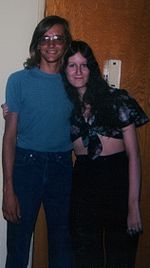
Another trend for both sexes was the fitted blazer, which flared slightly at the hip. It came in a variety of fabrics, including wool, velvet, suede, and leather. The buttons were covered and the lapels wide.
The jersey wrap dress
Wrap dress
A wrap dress is a dress with a front closure formed by wrapping one side across the other and knotting the attached ties that wrap around the back at the waist, or fastening buttons. This forms a V-shaped neckline and hugs a woman's curves...
, first designed by Diane von Fürstenberg
Diane von Fürstenberg
Diane von Fürstenberg, formerly Princess Diane of Fürstenberg , is a Belgian-American fashion designer best known for her iconic wrap dress. She initially rose to prominence when she married into the German princely House of Fürstenberg, as the wife of Prince Egon of Fürstenberg...
in 1972, became an extremely popular item, as it flattered a number of different body types and sizes, and could be worn both to the office, as well as to nightclubs and discos.
For teenage girls and young women the crop top
Crop top
A crop top is a T-shirt or blouse with the lower part cut off, showing of some of the abdomen. The half shirt is a kind of shirt that is cut off from the bottom of the chest....
was often worn, sometimes with a halter neck or else tied in a knot above the midriff.
By the mid-1970s hip-huggers were gone, replaced by the high-waisted jeans and trousers with wide, flared legs. In Britain, they were often referred to as "Loon pants". These lasted until the end of the decade when the straight, cigarette-leg jeans came into vogue.
In Britain and Ireland, in the early to mid-1970s, there was the bootboy subculture which influenced youthful male attire with the "parallel jeans", which were flared jeans that stopped at mid-calf. These were worn with heavy workman's "bovver" boots, braces, (US suspenders
Suspenders
Suspenders or braces are fabric or leather straps worn over the shoulders to hold up trousers. Straps may be elasticated, either entirely or only at attachment ends and most straps are of woven cloth forming an X or Y shape at the back. Braces are typically attached to trousers with buttons...
), and denim jackets. Their hair was usually worn longish by the middle of the decade.
The wrinkled look for women enjoyed a brief vogue in 1975, as did flared denim skirts which ended just below the knee. Trendy colours were dusty rose, Prussian blue, bottle green, rust, and brown.

Sundress
A sundress is a dress intended to be worn by women in warm weather. Typically, it is an informal or casual dress in a lightweight fabric, most commonly cotton, and usually loose fitting. The dress is intended to be worn without a layering top, and the design must therefore cut a balance between...
coupled with a tight t-shirt worn underneath enjoyed a brief popularity.
Late 1970s
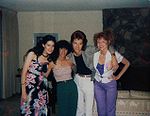
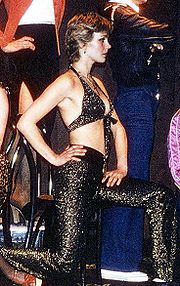
Bell-bottoms
Bell-bottoms are trousers that become wider from the knees downward. Related styles include flare, loon pants and boot-cut/leg trousers. Hip-huggers are bell-bottomed, flare, or boot-cut pants that are fitted tightly around the hips and thighs.-Naval origins:Bell-bottoms' precise origins are...
trousers, and high-rise waistcoats (US vests). Neckties became wider and bolder, and shirt collars became long and pointed in a style reminiscent of the "Barrymore" collar that had been popular in the 1920s. The zippered jumpsuit
Jumpsuit
Jumpsuit originally referred to the utilitarian one-piece garments used by parachuters/skydivers, but has come to be used as a common term for any one-piece garment with sleeves and legs.-Use:...
was popular with both men and women, and clothing inspired by modern dance (wrap
Wrap (clothing)
A wrap, in the context of clothing, is a simple skirt-type garment made by wrapping a piece of material round the lower body. Many people of both genders throughout the world wear wraps in everyday life, however, in the West, they are largely worn by women. They are sometimes sewn at the edges to...
skirts and dresses
Wrap dress
A wrap dress is a dress with a front closure formed by wrapping one side across the other and knotting the attached ties that wrap around the back at the waist, or fastening buttons. This forms a V-shaped neckline and hugs a woman's curves...
of rayon or jersey
Jersey (fabric)
Jersey is a knit fabric used predominantly for clothing manufacture. It was originally made of wool, but is now made of wool, cotton, and synthetic fibres. Since medieval times Jersey, Channel Islands, where the material was first produced, had been an important exporter of knitted goods and the...
) also became common. Neck-scarves were also used. Polyester, double knitting, skin-tight Spandex
Spandex
Spandex or elastane is a synthetic fibre known for its exceptional elasticity. It is strong, but less durable than natural Latex, its major non-synthetic competitor. It is a polyurethane-polyurea copolymer that was co-invented in 1959 by chemists C. L. Sandquist and Joseph Shivers at DuPont's...
trousers, tube top
Tube top
A tube top is a shoulderless, sleeveless "tube" that wraps the torso. Such a top is generally very tight over the breasts in order to prevent the garment from falling...
s, and slit skirts were popular for a while at the very end of the decade. In 1978, there was a brief craze for transparent plastic trousers worn with leotard
Leotard
A leotard is a skin-tight one-piece garment that covers the torso but leaves the legs free. It was made famous by the French acrobatic performer Jules Léotard ....
s underneath. Silk
Silk
Silk is a natural protein fiber, some forms of which can be woven into textiles. The best-known type of silk is obtained from the cocoons of the larvae of the mulberry silkworm Bombyx mori reared in captivity...
blouses, spaghetti-strapped tank tops and shirt-waist dresses were also worn. Women's shoes began to echo the 1940s, with high-heeled lower-platform mules
Mule (footwear)
Mule, a French word, is a style of shoe that is backless and often closed-toed. Mules can be any heel height - from flat to high. The style is predominantly worn by women....
--"Candies" made of molded plastic with a single leather strap over the ball of the foot or "BareTraps" made of wood becoming very popular. With the brief decline of disco late in 1979, these styles (which were by then being criticized as flamboyant) quickly went out of fashion. Designer jeans with straight, cigarette-legs, and painters' pants then started to come into style.
The top fashion models of the 1970s were Lauren Hutton
Lauren Hutton
Lauren Hutton is an American model and actress. She is best-known for her starring roles in the movies American Gigolo and Lassiter, and also for her fashion modeling career.-Personal life:...
, Margaux Hemingway
Margaux Hemingway
Margaux Hemingway was an American fashion model and actress.- Early life :Margot Louise Hemingway was born in Portland, Oregon, and was the older sister of actress Mariel Hemingway and the granddaughter of writer Ernest Hemingway...
, Gia Carangi
Gia Carangi
Gia Marie Carangi was an American fashion model during the late 1970s and early 1980s. Carangi is considered by some to be the first supermodel, although that title has been given to others, including Janice Dickinson, Dorian Leigh, and Jean Shrimpton...
, Janice Dickinson
Janice Dickinson
Janice Doreen Dickinson is an American actress, author, fashion photographer, model and talent agent.Initially notable as a model, she has described herself as the first supermodel. One of the most successful models throughout the 1970s and 1980s, she expanded her profession to reality television...
, Cheryl Tiegs
Cheryl Tiegs
Cheryl Rae Tiegs is an American model and actress.- Early years :Tiegs was born in Breckenridge, Minnesota but raised in Alhambra, California, and she graduated from Alhambra High School in 1965. She also attended the California State University, Los Angeles and became a little sister to the Sigma...
, and Jerry Hall
Jerry Hall
Jerry Faye Hall is an American model and actress, also known for her long-term relationship with Mick Jagger, with whom she had four children.-Early life:...

Custom T-Shirts / Baseball Jerseys
Short-sleeved t-shirts of various colors personalized with iron-onIron-on
Iron-on transfers are images that can be imprinted on fabric. They are frequently used to print onto T-shirts.On one side is paper, and on the other is the image that will be transferred in reverse. After placing it on the fabric and either running over the fabric side with an iron or pressing...
decal illustrations or appliquéd letters spelling a name or message were very popular among teen and pre-teen boys in the U.S. during the late 70s. It was also the trend for teenagers and young men to carry a pack of cigarettes under the sleeve.
Also popular were baseball jerseys or "baseball sleeves" (white shirts with colored sleeves worn under baseball uniform shirts). These were worn plain or with appliquéd pictures or words, as described above.
Leotards
The dancer's leotardLeotard
A leotard is a skin-tight one-piece garment that covers the torso but leaves the legs free. It was made famous by the French acrobatic performer Jules Léotard ....
became an important feminine fashion accessory in 1974, and remained in style throughout the decade. The traditional long-sleeve leotard was popular as the "layered style" of the mid-1970s took hold, where it served less as clothing than as a way to add color and texture to the body. In the late 1970s the leotard had become a standard fashion icon of the disco scene, where flexibility and ease of movement were important. It was helped by an extensive advertising campaign in the late 1970s by Danskin which promoted their leotards and tights as "not just for dancing". Celebrities of the 1970s also appeared regularly wearing leotards, including Joni Mitchell
Joni Mitchell
Joni Mitchell, CC is a Canadian musician, singer songwriter, and painter. Mitchell began singing in small nightclubs in her native Saskatchewan and Western Canada and then busking in the streets and dives of Toronto...
, Cher
Cher
Cher is an American recording artist, television personality, actress, director, record producer and philanthropist. Referred to as the Goddess of Pop, she has won an Academy Award, a Grammy Award, an Emmy Award, three Golden Globes and a Cannes Film Festival Award among others for her work in...
, and even Rod Stewart
Rod Stewart
Roderick David "Rod" Stewart, CBE is a British singer-songwriter and musician, born and raised in North London, England and currently residing in Epping. He is of Scottish and English ancestry....
. The leotards popularity was still climbing at the end of the decade, and exploded with the arrival of the aerobics craze in the early 1980s.
One-Piece Swimsuits
American actress Farrah FawcettFarrah Fawcett
Farrah Fawcett was an American actress and artist. A multiple Golden Globe and Emmy Award nominee, Fawcett rose to international fame when she first appeared as private investigator Jill Munroe in the first season of the television series Charlie's Angels, in 1976...
, who starred in the 1970s programme Charlie's Angels
Charlie's Angels
Charlie's Angels is a television series about three women who work for a private investigation agency, and is one of the first shows to showcase women in roles traditionally reserved for men...
, was a sex symbol
Sex symbol
A sex symbol is a celebrity of either gender, typically an actor, musician, supermodel, teen idol, or sports star, noted for their sex appeal. The term was first used in the mid 1950s in relation to the popularity of certain Hollywood stars, especially Marilyn Monroe and Brigitte...
for that time period. Her poster which was released in 1976 and sold 12 million copies, featured the actress with her long mane of streaked-blonde hair, perfect white teeth, and wearing a one-piece swimsuit
Swimsuit
A swimsuit, bathing suit, or swimming costume is an item of clothing designed to be worn by men, women or children while they are engaging in a water-based activity or water sports, such as swimming, water polo, diving, surfing, water skiing, or during activities in the sun, such as sun bathing.A...
that launched the trend for the maillot
Maillot
The maillot is the fashion designer's name for a woman's one-piece swimsuit, also called a tank suit. A maillot swimsuit generally consists of a tank-style torso top with high-cut legs...
. This was, when it resurged in the 1970s, a sexy, tight swimsuit, with deep neckline and high-cut legs, worn by young women and girls in lieu of the bikini, although it did not entirely replace the latter.
Three-Piece Suits
The 1970s saw a return to three-piece suits (suits with matching vests), worn with the wide-collar shirts carried over fre were worn without ties as dance-club wear, or even in just a vest and jacket combination as depicted in the film Saturday Night FeverSaturday Night Fever
Saturday Night Fever is a 1977 drama film directed by John Badham and starring: John Travolta as Tony Manero, an immature young man whose weekends are spent visiting a local Brooklyn discothèque; Karen Lynn Gorney as his dance partner and eventual friend; and Donna Pescow as Tony's former dance...
. As formal wear, however, the three-piece slowly died out in the early 1980s, by which time the outfit had come to be associated with lawyers.
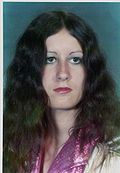
Hairstyles
Throughout much of the decade, women and teenage girls wore their hair long, with a centre or side parting, which was a style carried over from the late 1960s. Other hairstyles of the early to mid 1970s included the wavy "gypsy" cut, the layered shagShag (hairstyle)
A shag cut is a hairstyle that has been layered to various lengths. It was created by the barber Paul McGregor. The layers are often feathered at the top and sides. The layers make the hair full around the crown, and the hair thins to fringes around the edges...
, and the "flicked" style, popularly referred to as "wings", in which the hair was flicked into resembling small wings at the temples. This look was popularised by the stars of the television series Charlie's Angels
Charlie's Angels
Charlie's Angels is a television series about three women who work for a private investigation agency, and is one of the first shows to showcase women in roles traditionally reserved for men...
. Blonde-streaked or "frosted" hair was also popular. In 1977, punk singer Debbie Harry
Debbie Harry
Deborah Ann "Debbie" Harry is an American singer-songwriter and actress, best known for being the lead singer of the punk rock and new wave band Blondie. She has also had success as a solo artist, and in the mid-1990s she performed and recorded as part of The Jazz Passengers...
of Blondie
Blondie (band)
Blondie is an American rock band, founded by singer Deborah Harry and guitarist Chris Stein. The band was a pioneer in the early American New Wave and punk scenes of the mid-1970s...
sparked a new trend with her shoulder-length, dyed platinum blonde
Platinum Blonde
Platinum Blonde may refer to:* Platinum Blonde , a 1931 film starring Jean Harlow* Platinum Blonde , a Canadian New Wave music band, popular in the 1980s* Platinum blonde, a color of hair...
hair worn with a long fringe
Fringe (hair)
Fringe are a shaped cutting of the front part of the hair so that it is combed forward and hangs or curls over the forehead. A classic fringe is cut fairly straight at or above the eyebrows, but fringes can also be ragged or ruffled, spiked up with hair gel, swept to one side or the other, and...
(bangs). Young men's hair was worn long until well past the mid-1970s. Unlike the unkempt 1960s, it was often worn styled in soft layers. In California, the tousled blond, surfer hair
Surfer hair
Surfer hair is a tousled type of hairstyle, popularized by surfers from the 1950s onwards, traditionally long, thick and naturally bleached from high exposure to the sun and salt water of the sea. In the late 1960s and 1970s, the long hair and general lack of personal grooming was closely...
was fashionable for teenage boys and young men. In the early part of the decade sideburns
Sideburns
Sideburns or sideboards are patches of facial hair grown on the sides of the face, extending from the hairline to below the ears and worn with an unbearded chin...
were popular. For Blacks
Black people
The term black people is used in systems of racial classification for humans of a dark skinned phenotype, relative to other racial groups.Different societies apply different criteria regarding who is classified as "black", and often social variables such as class, socio-economic status also plays a...
in the United States and elsewhere, the afro
Afro
Afro, sometimes shortened to fro and also known as a "natural", is a hairstyle worn naturally by people with lengthy kinky hair texture or specifically styled in such a fashion by individuals with naturally curly or straight hair...
was worn by both sexes throughout the decade. It was occasionally sported by whites
White people
White people is a term which usually refers to human beings characterized, at least in part, by the light pigmentation of their skin...
as an alternative to the uniform long, straight hair which was a fashion mainstay until the arrival of punk and the "disco look" when hair became shorter and centre partings were no longer the mode.
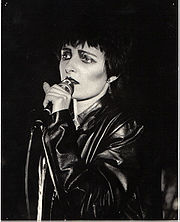
Punk
PunkPunk fashion
Punk fashion is the clothing, hairstyles, cosmetics, jewelry, and body modifications of the punk subculture. Punk fashion varies widely, ranging from Vivienne Westwood designs to styles modeled on bands like The Exploited. The distinct social dress of other subcultures and art movements, including...
as a style originated from London from the designer Vivienne Westwood
Vivienne Westwood
Dame Vivienne Westwood, DBE, RDI is a British fashion designer and businesswoman, largely responsible for bringing modern punk and new wave fashions into the mainstream.-Early life:...
and her partner Malcolm McLaren
Malcolm McLaren
Malcolm Robert Andrew McLaren was an English performer, impresario, self-publicist and manager of the Sex Pistols and the New York Dolls...
. Before the Modern world a punk was a person who attacked someone's cherished beliefs, traditional institutions, etc., based on error or superstition. Due to the harsh economic realities of Europe and Britain in the early to mid '70s, this movement was a direct reaction to the economic situation during the economic depression of the period. Punk had at its heart a manifesto of creation through disorder. Safety pins became nose and ear jewellery, rubber fetishwear was subverted to become daywear, and images of mass murderers, rapists, and criminals were elevated to iconographic status.
Punk fashion
Punk fashion
Punk fashion is the clothing, hairstyles, cosmetics, jewelry, and body modifications of the punk subculture. Punk fashion varies widely, ranging from Vivienne Westwood designs to styles modeled on bands like The Exploited. The distinct social dress of other subcultures and art movements, including...
can be traced to the ripped jeans, torn t-shirts, scrappy haircuts, and worn and torn leather jackets sported by members of the Sex Pistols
Sex Pistols
The Sex Pistols were an English punk rock band that formed in London in 1975. They were responsible for initiating the punk movement in the United Kingdom and inspiring many later punk and alternative rock musicians...
. When they released Anarchy in the UK in 1976,The Sex Pistols were dressed by Malcolm McLaren
Malcolm McLaren
Malcolm Robert Andrew McLaren was an English performer, impresario, self-publicist and manager of the Sex Pistols and the New York Dolls...
, their manager, whose partner Vivienne Westwood owned a clothes store called "Let It Rock" in the Kings Road, Chelsea
Chelsea, London
Chelsea is an area of West London, England, bounded to the south by the River Thames, where its frontage runs from Chelsea Bridge along the Chelsea Embankment, Cheyne Walk, Lots Road and Chelsea Harbour. Its eastern boundary was once defined by the River Westbourne, which is now in a pipe above...
area of London. These styles can be traced back further to New York artists at the Andy Warhol
Andy Warhol
Andrew Warhola , known as Andy Warhol, was an American painter, printmaker, and filmmaker who was a leading figure in the visual art movement known as pop art...
Factory or bands such as the Velvet Underground, Patti Smith Group
Patti Smith
Patricia Lee "Patti" Smith is an American singer-songwriter, poet and visual artist, who became a highly influential component of the New York City punk rock movement with her 1975 debut album Horses....
or New York Dolls
New York Dolls
The New York Dolls is an American rock band, formed in New York in 1971. The band's protopunk sound prefigured much of what was to come in the punk rock era; their visual style influenced the look of many new wave and 1980s-era glam metal groups, and they began the local New York scene that later...
. By the 1980s, punk fashion and punk bands had shown up in cities across the world. There was a Do It Yourself quality to the fashion. Some small elements that spoke of a person's punk roots were safety pins, black PVC or tartan
Tartan
Tartan is a pattern consisting of criss-crossed horizontal and vertical bands in multiple colours. Tartans originated in woven wool, but now they are made in many other materials. Tartan is particularly associated with Scotland. Scottish kilts almost always have tartan patterns...
bondage trousers, leopard-print t-shirts, mohawk
Mohawk hairstyle
The mohawk is a hairstyle in which, in the most common variety, both sides of the head are shaven, leaving a strip of noticeably longer hair...
, spikes or harshly dyed hair, filthy tennis-shoes, or pointy Beatle boots. There is an element of a makeshift, thrown together look and a sense of poverty.
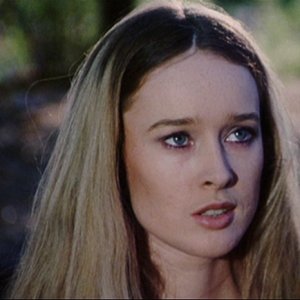
Cosmetics
CosmeticsCosmetics
Cosmetics are substances used to enhance the appearance or odor of the human body. Cosmetics include skin-care creams, lotions, powders, perfumes, lipsticks, fingernail and toe nail polish, eye and facial makeup, towelettes, permanent waves, colored contact lenses, hair colors, hair sprays and...
in the 1970s reflected the contradictory roles ascribed for the modern woman. For the first time since 1900, make-up was chosen situationally, rather than in response to monolithic trends. The era's two primary visions were the daytime "natural look" presented by American designers and Cosmopolitan
Cosmopolitan (magazine)
Cosmopolitan is an international magazine for women. It was first published in 1886 in the United States as a family magazine, was later transformed into a literary magazine and eventually became a women's magazine in the late 1960s...
magazine, and the evening aesthetic of sexualized glamour presented by European designers and fashion photographers. In the periphery, punk and glam were also influential. The struggling cosmetics industry attempted to make a comeback, using new marketing and manufacturing practices.

